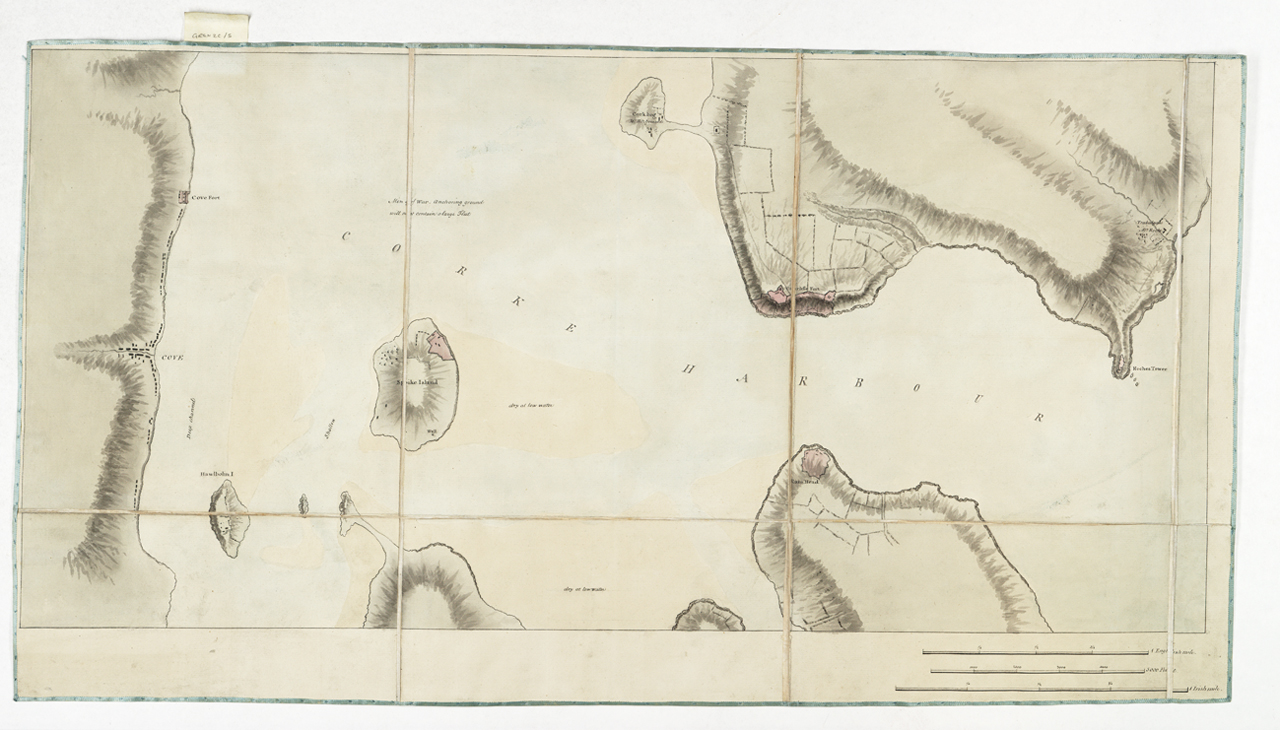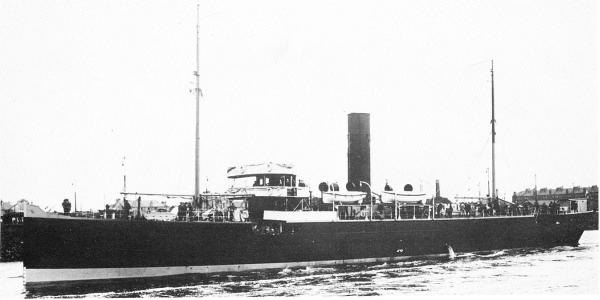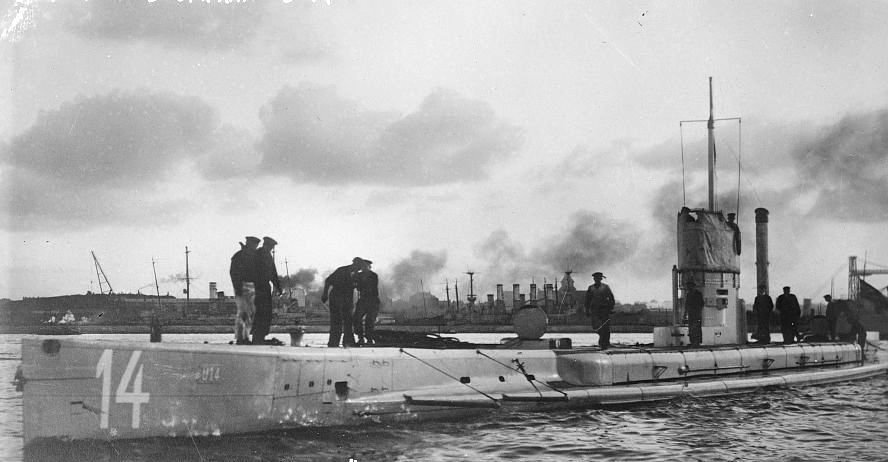|
SM UC-29
SM ''UC-29'' was a German Type UC II minelaying submarine or U-boat in the German Imperial Navy (german: Kaiserliche Marine) during World War I. The U-boat was ordered on 29 August 1915 and was launched on 15 July 1916. She was commissioned into the German Imperial Navy on 15 August 1916 as SM ''UC-29''."SM" stands for "Seiner Majestät" ( en, His Majesty's) and combined with the ''U'' for ''Unterseeboot'' would be translated as ''His Majesty's Submarine''. In an eight-month career, the ''UC-29'' performed seven combat patrols into the Atlantic Ocean during the German war on Allied trade (''Handelskrieg''). In these patrols she was very successful, sinking 18 allied ships, totalling 21,909 GRT. She also damaged 4 ships of 17,154 GRT. On 7 June 1917 she torpedoed the British Q-ship off the Irish coast, but was ambushed by her hidden armaments when she approached too close and was sunk with 23 hands. ''Pargust'' was commanded by British submarine hunter Gordon Campbell and ... [...More Info...] [...Related Items...] OR: [Wikipedia] [Google] [Baidu] |
German Empire
The German Empire (),Herbert Tuttle wrote in September 1881 that the term "Reich" does not literally connote an empire as has been commonly assumed by English-speaking people. The term literally denotes an empire – particularly a hereditary empire led by an emperor, although has been used in German to denote the Roman Empire because it had a weak hereditary tradition. In the case of the German Empire, the official name was , which is properly translated as "German Empire" because the official position of head of state in the constitution of the German Empire was officially a "presidency" of a confederation of German states led by the King of Prussia who would assume "the title of German Emperor" as referring to the German people, but was not emperor of Germany as in an emperor of a state. –The German Empire" ''Harper's New Monthly Magazine''. vol. 63, issue 376, pp. 591–603; here p. 593. also referred to as Imperial Germany, the Second Reich, as well as simply Germany, ... [...More Info...] [...Related Items...] OR: [Wikipedia] [Google] [Baidu] |
World War I
World War I (28 July 1914 11 November 1918), often abbreviated as WWI, was one of the deadliest global conflicts in history. Belligerents included much of Europe, the Russian Empire, the United States, and the Ottoman Empire, with fighting occurring throughout Europe, the Middle East, Africa, the Pacific, and parts of Asia. An estimated 9 million soldiers were killed in combat, plus another 23 million wounded, while 5 million civilians died as a result of military action, hunger, and disease. Millions more died in genocides within the Ottoman Empire and in the 1918 influenza pandemic, which was exacerbated by the movement of combatants during the war. Prior to 1914, the European great powers were divided between the Triple Entente (comprising France, Russia, and Britain) and the Triple Alliance (containing Germany, Austria-Hungary, and Italy). Tensions in the Balkans came to a head on 28 June 1914, following the assassination of Archduke Franz Ferdin ... [...More Info...] [...Related Items...] OR: [Wikipedia] [Google] [Baidu] |
Draught (ship)
The draft or draught of a ship's hull is the vertical distance between the waterline and the bottom of the hull (keel). The draught of the vessel is the maximum depth of any part of the vessel, including appendages such as rudders, propellers and drop keels if deployed. Draft determines the minimum depth of water a ship or boat can safely navigate. The related term air draft is the maximum height of any part of the vessel above the water. The more heavily a vessel is loaded, the deeper it sinks into the water, and the greater its draft. After construction, the shipyard creates a table showing how much water the vessel displaces based on its draft and the density of the water (salt or fresh). The draft can also be used to determine the weight of cargo on board by calculating the total displacement of water, accounting for the content of the ship's bunkers, and using Archimedes' principle. The closely related term "trim" is defined as the difference between the forward and aft ... [...More Info...] [...Related Items...] OR: [Wikipedia] [Google] [Baidu] |
Beam (ship)
The beam of a ship is its width at its widest point. The maximum beam (BMAX) is the distance between planes passing through the outer extremities of the ship, beam of the hull (BH) only includes permanently fixed parts of the hull, and beam at waterline (BWL) is the maximum width where the hull intersects the surface of the water. Generally speaking, the wider the beam of a ship (or boat), the more initial stability it has, at the expense of secondary stability in the event of a capsize, where more energy is required to right the vessel from its inverted position. A ship that heels on her ''beam ends'' has her deck beams nearly vertical. Typical values Typical length-to-beam ratios ( aspect ratios) for small sailboats are from 2:1 (dinghies to trailerable sailboats around ) to 5:1 (racing sailboats over ). Large ships have widely varying beam ratios, some as large as 20:1. Rowing shells designed for flatwater racing may have length to beam ratios as high as 30:1, while a cor ... [...More Info...] [...Related Items...] OR: [Wikipedia] [Google] [Baidu] |
Length Overall
__NOTOC__ Length overall (LOA, o/a, o.a. or oa) is the maximum length of a vessel's hull measured parallel to the waterline. This length is important while docking the ship. It is the most commonly used way of expressing the size of a ship, and is also used for calculating the cost of a marina berth (for example, £2.50 per metre LOA). LOA is usually measured on the hull alone. For sailing ships, this may ''exclude'' the bowsprit and other fittings added to the hull. This is how some racing boats and tall ships use the term LOA. However, other sources may include bowsprits in LOA. Confusingly, LOA has different meanings. "Sparred length", "Total length including bowsprit", "Mooring length" and "LOA including bowsprit" are other expressions that might indicate the full length of a sailing ship. LOD Often used to distinguish between the length of a vessel including projections (e.g. bow sprits, etc.) from the length of the hull itself, the Length on Deck or LOD is often repor ... [...More Info...] [...Related Items...] OR: [Wikipedia] [Google] [Baidu] |
Cork Harbour
Cork Harbour () is a natural harbour and river estuary at the mouth of the River Lee in County Cork, Ireland. It is one of several which lay claim to the title of "second largest natural harbour in the world by navigational area" (after Port Jackson, Sydney). Other contenders include Halifax Harbour in Canada, Trincomalee Harbour in Sri Lanka and Poole Harbour in England. The harbour has been a working port and a strategic defensive hub for centuries, and it has been one of Ireland's major employment hubs since the early 1900s. Traditional heavy industries have waned since the late 20th century, with the likes of the closure of Irish Steel in Haulbowline and shipbuilding at Verolme. It still has strategic significance in energy generation, shipping, refining and pharmaceuticals development. Geography The main tributary to the harbour is the River Lee which, after flowing through Cork city, passes through the upper harbour (Lough Mahon) in the northwest before passing to the we ... [...More Info...] [...Related Items...] OR: [Wikipedia] [Google] [Baidu] |
Victoria Cross
The Victoria Cross (VC) is the highest and most prestigious award of the British honours system. It is awarded for valour "in the presence of the enemy" to members of the British Armed Forces and may be awarded posthumously. It was previously awarded by countries of the Commonwealth of Nations, most of which have established their own honours systems and no longer recommend British honours. It may be awarded to a person of any military rank in any service and to civilians under military command. No civilian has received the award since 1879. Since the first awards were presented by Queen Victoria in 1857, two-thirds of all awards have been personally presented by the British monarch. The investitures are usually held at Buckingham Palace. The VC was introduced on 29 January 1856 by Queen Victoria to honour acts of valour during the Crimean War. Since then, the medal has been awarded 1,358 times to 1,355 individual recipients. Only 15 medals, of which 11 to members of the Britis ... [...More Info...] [...Related Items...] OR: [Wikipedia] [Google] [Baidu] |
William Williams (VC)
William Williams Victoria Cross, VC, Distinguished Service Medal (United Kingdom), DSM & Bar (5 October 1890 – 22 October 1965), was a Wales, Welsh recipient of the Victoria Cross, the highest and most prestigious award for gallantry in the face of the enemy that can be awarded to a member of the United Kingdom, British and Commonwealth of Nations, Commonwealth armed forces. He was from Amlwch on Anglesey and at age 26 was serving as a Seaman (rank), seaman in the Royal Naval Reserve during the First World War when the following deed took place: * On 7 June 1917, Ronald Niel Stuart#HMS Pargust, HMS ''Pargust'' (a Q ship) was out in the Atlantic Ocean when her engine room was damaged by a torpedo fired from the U-boat . The explosion loosened the gun covers and Seaman Williams, with great presence of mind, took the whole weight on himself and physically prevented the covers from falling and betraying the ship to the enemy. The Pargust's 'panic party', the decoy crew carried ... [...More Info...] [...Related Items...] OR: [Wikipedia] [Google] [Baidu] |
Ronald Niel Stuart
Ronald Niel Stuart, VC, DSO, RD, RNR (26 August 1886 – 8 February 1954) was a British Merchant Navy commodore and Royal Navy captain who was highly commended following extensive and distinguished service at sea over a period of more than thirty-five years. During World War I he was awarded the Victoria Cross, the Distinguished Service Order, the French Croix de Guerre avec Palmes and the United States' Navy Cross for a series of daring operations he conducted while serving in the Royal Navy against the German U-boat campaign in the Atlantic. Stuart received his Victoria Cross following a ballot by the men under his command. This unusual method of selection was used after the Admiralty board was unable to choose which members of the crew deserved the honour after a desperate engagement between a Q-ship and a German submarine off the Irish coast. His later career included command of the liner RMS ''Empress of Britain'' and the management of the London office of a major t ... [...More Info...] [...Related Items...] OR: [Wikipedia] [Google] [Baidu] |
Gordon Campbell (VC)
Vice admiral Gordon Campbell, (6 January 1886 – 3 October 1953) was a British naval officer, writer, politician and a recipient of the Victoria Cross, the highest award for gallantry in the face of the enemy that can be awarded to British and Commonwealth forces. He was also awarded the Croix de Guerre and appointed a chevalier of the Légion d'honneur for his actions during the First World War. Early life and career Born on 6 January 1886 to Frederick Campbell, he was educated at Dulwich College, which he attended between 1898 and 1900. He then joined the Royal Navy and was in October 1902 posted as a midshipman to the battleship serving in the Mediterranean Sea. He was promoted to lieutenant in 1907 and to commander in March 1916. It was during the First World War that he was awarded the Victoria Cross for the following action: Campbell also commanded during the action of 8 August 1917 when she was sunk by SM ''UC-71''. Victoria Crosses were awarded to two members of ... [...More Info...] [...Related Items...] OR: [Wikipedia] [Google] [Baidu] |
Q-ship
Q-ships, also known as Q-boats, decoy vessels, special service ships, or mystery ships, were heavily armed merchant ships with concealed weaponry, designed to lure submarines into making surface attacks. This gave Q-ships the chance to open fire and sink them. The use of Q-ships contributed to the abandonment of cruiser rules restricting attacks on unarmed merchant ships and to the shift to unrestricted submarine warfare in the 20th century. They were used by the British Royal Navy and the German ''Kaiserliche Marine'' during the First World War and by the Royal Navy, the '' Kriegsmarine'', and the United States Navy during the Second World War (1939–45). Etymology Short for Queenstown in Ireland, as Haulbowline Dockyard in Cork Harbour was responsible for the conversion of many mercantile steamers to armed decoy ships in World War One, although the majority appear to have been converted in larger navy yards such as Devonport. Early uses of the concept In the 1670s, ... [...More Info...] [...Related Items...] OR: [Wikipedia] [Google] [Baidu] |
Handelskrieg
The U-boat Campaign from 1914 to 1918 was the World War I naval campaign fought by German U-boats against the trade routes of the Allies. It took place largely in the seas around the British Isles and in the Mediterranean. The German Empire relied on imports for food and domestic food production (especially fertilizer) and the United Kingdom relied heavily on imports to feed its population, and both required raw materials to supply their war industry; the powers aimed, therefore, to blockade one another. The British had the Royal Navy which was superior in numbers and could operate on most of the world's oceans because of the British Empire, whereas the Imperial German Navy surface fleet was mainly restricted to the German Bight, and used commerce raiders and unrestricted submarine warfare to operate elsewhere. In the course of events in the Atlantic alone, German U-boats sank almost 5,000 ships with nearly 13 million gross register tonnage, losing 178 boats and about 5, ... [...More Info...] [...Related Items...] OR: [Wikipedia] [Google] [Baidu] |





